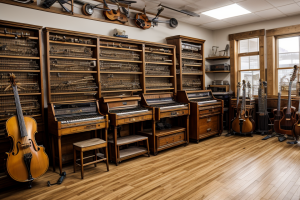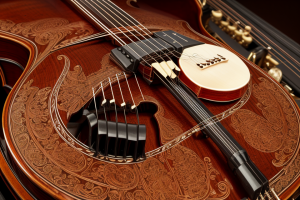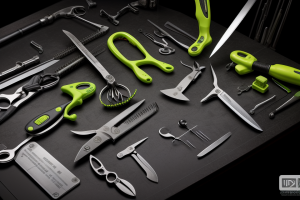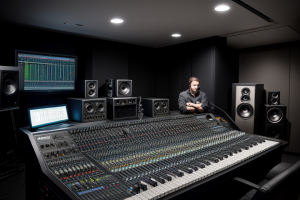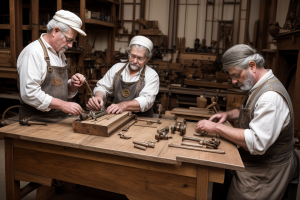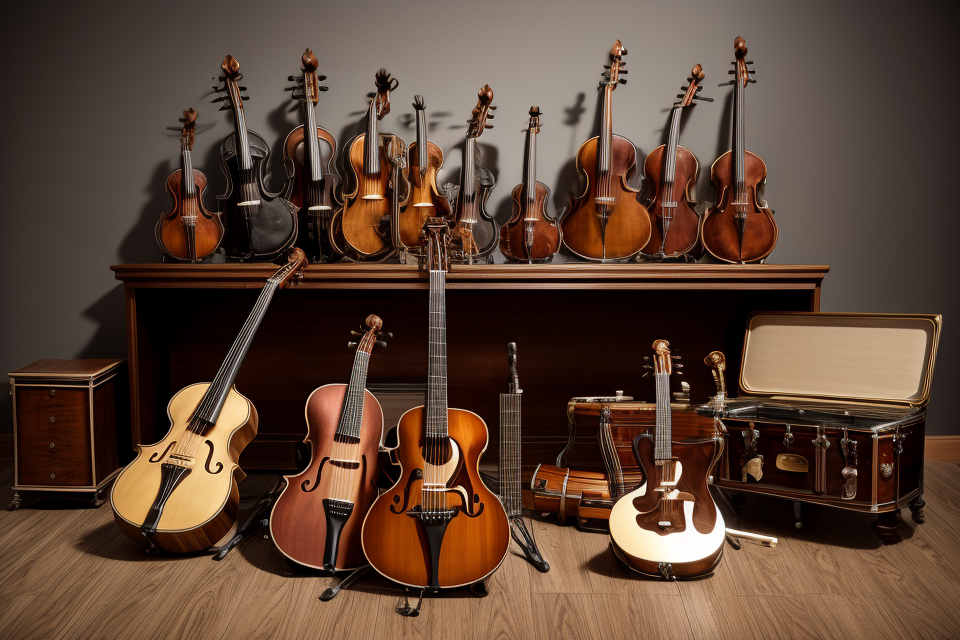
The question of what the most beautiful sounding instrument is, is a matter of personal taste and preference. Some may argue that the piano, with its rich and dynamic sound, holds the title, while others may contend that the violin, with its soaring melodies, is the most beautiful sounding instrument. Still, others may believe that the hauntingly beautiful sound of the cello or the warm and inviting tones of the guitar are the most captivating. In this comprehensive guide, we will explore the characteristics and qualities that make various instruments so alluring to the ear, and ultimately, determine which one deserves the title of the most beautiful sounding instrument.
The Melodic Appeal of Musical Instruments
Understanding the Elements of Sound
The elements of sound are the fundamental components that make up the auditory experience. These elements are essential to understanding why some musical instruments sound more beautiful than others. By examining the characteristics of frequency, timbre, amplitude, and volume, we can gain a deeper appreciation for the melodic appeal of various instruments.
Frequency and Timbre
Frequency refers to the rate at which a sound wave oscillates, measured in hertz (Hz). In musical instruments, the frequency of the sound wave determines the pitch of the instrument. For example, a guitar string vibrating at 250 Hz will produce a lower pitch than a string vibrating at 400 Hz. The human ear is sensitive to a wide range of frequencies, allowing us to distinguish between different pitches and harmonies.
Timbre, on the other hand, refers to the unique quality of a sound that distinguishes it from other sounds. It is the combination of the frequency spectrum and the envelope of the sound wave that creates the distinct timbre of an instrument. The timbre of an instrument is often described as its “tone color” and is influenced by factors such as the material of the instrument, its size, and the shape of the resonating chamber.
Amplitude and Volume
Amplitude refers to the magnitude of the oscillation of a sound wave, measured in decibels (dB). The amplitude of a sound wave determines its loudness or intensity. A higher amplitude results in a louder sound, while a lower amplitude produces a quieter sound. In musical instruments, the amplitude of the sound wave is determined by the force with which the instrument is played or the pressure of the air column in the instrument.
Volume, on the other hand, refers to the overall loudness of a sound, taking into account both the amplitude and the frequency response of the listening environment. The volume of a musical instrument is influenced by factors such as the size of the instrument, the material it is made of, and the skill of the player.
Understanding the elements of sound is crucial to appreciating the melodic appeal of different musical instruments. By examining the factors that contribute to the frequency, timbre, amplitude, and volume of sound waves, we can gain a deeper appreciation for the beauty and complexity of musical instruments.
How Instruments Create Sound
Instruments create sound through various mechanisms, each producing a unique timbre that contributes to their melodic appeal. This section will delve into the specific mechanisms of sound production for stringed, wind, and percussion instruments.
Stringed Instruments
Stringed instruments, such as violins, cellos, and guitars, create sound by vibrating strings. When a musician draws a bow across the strings or plucks them with their fingers, the strings vibrate at specific frequencies, producing sound waves. The shape and tension of the strings, along with the wooden body of the instrument, determine the unique timbre of each note. The vibrations of the strings are transmitted to the body of the instrument, which amplifies and projects the sound.
Wind Instruments
Wind instruments, like saxophones, trumpets, and flutes, create sound by vibrating a column of air. When a musician blows air into the mouthpiece or valves, they create a vibration that produces a specific frequency, resulting in a sound wave. The shape of the instrument and the placement of the embouchure (the mouthpiece) determine the unique timbre of each note. The vibrations are amplified and projected through the instrument’s body, creating a rich, resonant sound.
Percussion Instruments
Percussion instruments, such as drums, cymbals, and maracas, create sound through the vibration of a membrane or solid surface. The instrument is struck, scraped, or shaken, causing a vibration that produces a specific frequency, resulting in a sound wave. The material, shape, and tension of the membrane or surface, along with the wooden or metal body of the instrument, determine the unique timbre of each note. The vibrations are amplified and projected through the instrument’s body, creating a variety of rhythmic and melodic textures.
Understanding the mechanisms behind the creation of sound in various instruments is essential for appreciating their unique timbres and contributions to the symphony of music. Each instrument has its own voice, and learning to listen to the subtle nuances of their sound can enhance one’s appreciation for the art of music.
The Contenders: Top 5 Most Beautiful Sounding Instruments
1. Harp
The Enchanting Sounds of a Harp
The harp is often considered one of the most beautiful sounding instruments in the world. Its delicate strings and intricate design produce a sound that is both melodic and mesmerizing. The harp’s sound is characterized by its rich, warm tones and ethereal overtones, making it a favorite among classical and contemporary musicians alike.
The History and Evolution of the Harp
The harp has a long and storied history, dating back to ancient civilizations such as Egypt and Greece. Over time, the instrument evolved and developed new features, such as the pedal harp, which allowed for greater versatility and range. Today, the harp remains a beloved instrument, celebrated for its beauty and musicality.
2. Piano
The Timeless Appeal of the Piano
The piano is a timeless instrument that has captured the hearts of music lovers for centuries. Its ability to produce a wide range of sounds, from gentle and delicate to bold and powerful, has made it a staple in classical music, as well as in popular music genres such as jazz and rock. The piano’s versatility and expressiveness have made it a favorite among composers and performers alike, and its popularity has only continued to grow over time.
The Mechanics of a Piano
The piano is a complex instrument that consists of over 200 strings, which are struck by hammers when the keys are pressed. The sound is produced by the vibration of the strings, which is amplified by a soundboard and the wooden body of the instrument. The keys themselves are made of wood and are connected to a mechanism that allows the hammers to strike the strings. The keys are arranged in groups of black and white, with the black keys serving as sharps and flats between the white keys. The piano also has a pedal that allows the performer to sustain notes and create a richer, more complex sound.
3. Violin
The Soulful Melodies of the Violin
The violin is a four-stringed instrument that is widely regarded as one of the most beautiful sounding instruments in the world. Its distinctive sound is a result of its unique design and construction, which includes a hollow body, a wooden frame, and four strings that are plucked or bowed to produce music.
One of the reasons why the violin is so beloved is because of its versatility. It can be used to create a wide range of musical styles, from classical and orchestral music to jazz and popular music. Its rich, expressive sound has made it a favorite among composers and musicians for centuries, and its timeless appeal continues to captivate audiences today.
The Legacy of the Violin
The violin has a rich history that spans over 500 years. It was first developed in Italy during the 16th century, and since then, it has undergone many changes and evolutions. Some of the most famous violin makers include Stradivari, Giuseppe Guarneri, and Antonio Stradivari, whose instruments are highly prized by collectors and musicians alike.
The violin has also played a significant role in cultural and artistic movements throughout history. It was a central instrument in the Classical period, and its sound was featured prominently in the Romantic period. Today, the violin remains an essential part of classical music, and it continues to inspire new generations of musicians and composers.
In addition to its cultural significance, the violin has also been the subject of numerous scientific studies. Researchers have explored the physics of the instrument, examining the ways in which the strings and body produce sound, and how the player’s technique affects the final output. This knowledge has led to advancements in both violin design and playing techniques, and it continues to shape the way we understand and appreciate this beautiful instrument.
4. Cello
The Rich Tones of the Cello
The cello is renowned for its rich, deep tones that fill concert halls with warmth and resonance. Its low-pitched, full-bodied sound is achieved through the vibration of its strings, which are typically made of steel or gut. The cello’s unique timbre is further enhanced by its wooden body, which is typically made of spruce or maple. The instrument’s shape, size, and materials all contribute to its distinctive sound, making it one of the most beautiful sounding instruments in classical music.
The Cello’s Role in Chamber Music
The cello plays a vital role in chamber music, where it often shares the spotlight with other instruments such as the violin, viola, and piano. In these ensembles, the cello’s rich tones provide a counterpoint to the higher-pitched instruments, creating a harmonious blend of sounds. The cello’s versatility also allows it to take on a variety of roles, from the bass line in a string quartet to the melodic lead in a cello concerto.
In addition to its classical repertoire, the cello is also a staple in popular music, where it has been featured in a wide range of genres from rock to jazz. Its mellow, soulful sound has been used to great effect in songs by artists such as Paul McCartney, Sting, and Yo-Yo Ma. Whether played in a classical concert hall or a rock festival, the cello remains one of the most beautiful sounding instruments in the world.
5. Flute
The Soaring Sounds of the Flute
The flute is a woodwind instrument that has been praised for its soaring and ethereal sounds. Its distinctive tone is created by the musician blowing air across a flute mouthpiece, which vibrates to produce the desired notes. The flute’s design, which typically includes a metal or wooden body and a complex system of keys, allows for a wide range of musical expression.
The Flute’s Connection to Nature
The flute has been associated with nature since ancient times, and this connection is evident in its sound. The flute’s haunting melodies are often reminiscent of bird calls, and the instrument has been used in various cultures to imitate the sounds of nature. In addition, the flute’s shape and size are inspired by natural forms, such as feathers and leaves.
Another aspect of the flute’s connection to nature is its use in rituals and ceremonies. In many cultures, the flute has been used to communicate with the spirit world and to invoke the powers of nature. For example, Native American tribes have used the flute in healing ceremonies and to ask for blessings from the gods.
Despite its association with nature, the flute is also a highly technical instrument that requires great skill and precision to play. The musician must control the airflow and embouchure to produce the desired notes, and must also be able to navigate the flute’s complex system of keys. The challenge of mastering the flute has made it a favorite among accomplished musicians, who appreciate the instrument’s versatility and expressive potential.
Subjective Beauty: The Human Element
The Allure of Rare and Unique Instruments
Examples of Exceptional Instruments
Stradivarius Violin
The Stradivarius Violin is a legendary instrument, crafted by the Italian master luthier Antonio Stradivari during the 17th and 18th centuries. Stradivari’s violins are renowned for their rich, warm tones and exceptional craftsmanship. Only a few hundred Stradivarius violins remain today, and they are highly sought after by musicians and collectors alike. The sound produced by a Stradivarius is considered by many to be the epitome of the perfect violin tone, making it a prized possession for any virtuoso.
Hidalgo Cello
The Hidalgo Cello, created by the Spanish luthier, Juan Hernandez, is another highly sought-after instrument. Known for its rich, resonant sound, the Hidalgo Cello is characterized by its dark, full-bodied tones and powerful bass. The unique combination of woods used in its construction, along with its intricate design, contributes to its exceptional sound quality. The Hidalgo Cello is a rare find, with only a handful existing today, making it a highly prized possession for cellists and collectors alike.
Saxophone
The Saxophone, invented by the Belgian instrument maker, Adolphe Sax, in the mid-19th century, is a brass instrument known for its mellow, expressive sound. The Saxophone has a unique timbre that sets it apart from other brass instruments, making it a favorite among jazz and blues musicians. Its versatility and ability to produce a wide range of tones make it a highly sought-after instrument for various musical genres. Saxophones come in a variety of sizes, from the alto to the bass, each with its own distinct sound and range. The Saxophone’s beautiful sound has captivated musicians and audiences alike, making it a staple in many musical ensembles.
The Power of Collaboration: The Importance of Instruments in Ensembles
The Role of Instruments in Different Genres
Classical Music
In classical music, the role of instruments is carefully defined and structured. Each instrument has a specific function within the orchestra, from the delicate, high-pitched sounds of the violin and flute to the deep, rich tones of the cello and double bass. The violin, in particular, is often considered the star of the classical music world, with its soaring melodies and technical complexity. Other key instruments include the piano, which provides a solid foundation for the entire ensemble, and the French horn, whose warm, lyrical sound adds depth and emotion to the music.
Jazz
Jazz is a genre that is all about improvisation and spontaneity, but it still relies heavily on instruments and their unique sounds. The saxophone, trumpet, and piano are some of the most prominent instruments in jazz, each bringing its own distinct timbre to the music. The saxophone’s breathy, expressive sound is often used to take solos and create melodic lines, while the trumpet’s bright, brassy tones are perfect for punctuating the rhythm and adding energy to the music. The piano, with its rich, complex sound, provides a solid foundation for the entire ensemble, allowing other instruments to improvise and play off of its chords and rhythms.
Rock and Pop
In rock and pop music, the role of instruments is often more flexible and experimental. Electric guitars, basses, and keyboards are the backbone of most rock and pop bands, with their loud, distorted sounds and catchy melodies. The electric guitar, in particular, has become an iconic symbol of rock music, with its gritty, high-energy sound and ability to create complex, intricate solos. The bass guitar provides a solid foundation for the rhythm section, while keyboards and synthesizers add texture and color to the music. Drums, too, are an essential part of the rock and pop sound, with their driving rhythms and powerful, percussive sounds.
The Dynamics of Musical Performance
The dynamics of musical performance play a crucial role in the way that instruments interact with one another to create a harmonious and engaging musical experience. In an ensemble setting, each instrument brings its own unique timbre and tone to the table, and it is the careful balancing of these sounds that allows for a truly dynamic performance.
The Interplay of Instruments
One of the most important aspects of the dynamics of musical performance is the interplay between different instruments. Each instrument has its own set of characteristics that allow it to shine in certain contexts and recede into the background in others. For example, a violin may take the lead in a piece of classical music, while a saxophone may provide a soulful melody in a jazz tune.
In order to create a successful ensemble performance, it is important for each instrument to understand its role within the piece and how it contributes to the overall sound. This requires not only technical skill, but also a deep understanding of the music itself and the emotions that it is meant to evoke.
The Impact of Accompaniment
Another important aspect of the dynamics of musical performance is the role of accompaniment. In many cases, the accompaniment is responsible for providing a foundation for the melody to rest upon. This can be done through the use of chords, rhythmic patterns, or other musical elements that help to support the main theme of the piece.
A skilled accompanist must be able to adapt to the needs of the melody, providing just the right amount of support and allowing the lead instrument to shine. This requires a deep understanding of both the music and the instruments involved, as well as a strong sense of rhythm and timing.
Overall, the dynamics of musical performance are what make ensemble music so engaging and emotionally powerful. By carefully balancing the interplay of instruments and the impact of accompaniment, musicians can create a rich and varied musical landscape that captures the hearts and minds of their audience.
FAQs
1. What is the most beautiful sounding instrument?
There is no definitive answer to this question as beauty is subjective and varies from person to person. However, many people consider the piano, cello, and violin to be among the most beautiful sounding instruments due to their rich, warm, and expressive tones. Other instruments such as the guitar, flute, and harp are also widely appreciated for their beautiful sounds.
2. What makes an instrument sound beautiful?
There are several factors that can contribute to an instrument sounding beautiful. These include the quality of the materials used to make the instrument, the design and construction of the instrument, the skill of the player, and the type of music being played. Additionally, the timbre or tone color of an instrument, which is influenced by factors such as the size and shape of the instrument, the thickness and tension of the strings or reeds, and the resonance of the body, can also affect how beautiful it sounds.
3. Can an instrument be both beautiful and technically difficult to play?
Yes, it is possible for an instrument to be both beautiful and technically difficult to play. For example, the cello is known for its rich and expressive sound, but it is also considered one of the most technically challenging instruments to play. Similarly, the piano requires a high level of technical skill to play well, but its warm and complex sound is a major reason why it is considered one of the most beautiful sounding instruments.
4. Is it better to choose an instrument based on its beauty or its practicality?
The choice of instrument ultimately depends on the individual’s personal preferences and goals. While some people may prioritize the beauty of an instrument, others may prioritize its practicality, such as its versatility, portability, or affordability. Ultimately, the most important factor is finding an instrument that inspires and motivates the player to create music.
5. Can the beauty of an instrument be enhanced or altered through technology?
Yes, technology can be used to enhance or alter the beauty of an instrument. For example, electronic instruments such as synthesizers and samplers can create a wide range of sounds and textures that might not be possible with traditional acoustic instruments. Additionally, effects processors and digital signal processing techniques can be used to alter the timbre of an instrument or create new sounds. However, it is important to note that technology alone cannot create a beautiful sound; the player’s skill and artistry are still crucial factors in creating beautiful music.


